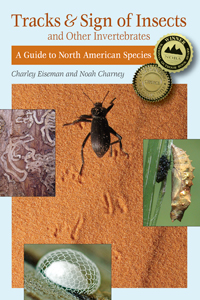I first mentioned the moth family Nepticulidae a couple of months ago when musing about the feathery wings of the tiniest insects. I included this photo, which shows the first adult nepticulid I ever encountered–this past July, on my bedroom window:
Nepticulids are certainly not rare, but nocturnal insects that are only 2 mm long are not easy to find, and I can’t say I’ve ever tried. I have no idea which one this is that I’ve photographed, although I’m guessing it’s a Stigmella species based on the examples at the Moth Photographers Group website (the nepticulids are #0037-0114). But with only 22 of the 97 described North American species accounted for, chances are good that it’s something not represented on that page.
A few nepticulids are gallmakers or barkminers, but the vast majority are leafminers. They are not the easiest leafminers to raise, because the larvae develop very quickly and then exit the leaf to pupate, so most mines you find will already be empty. So the day after I took the above photo, I was excited to find some nepticulid leaf mines with the larvae still in them. Look carefully and you can see the larva right about at the center of the photo below.
This is a tupelo (Nyssa sylvatica) leaf. The bumps on the leaf are galls caused by Aceria nyssae (Eriophyidae), a mite. The mites are pale and wormlike, totally unrelated to the two round shiny mites walking around on the leaf, which are oribatids, something like this:
Anyway, the long, narrow trail that begins the mine (in the lower left portion of the photo), with its continuous line of dark excrement down the center, helped me recognize it as the work of a nepticulid larva, and the fact that it was in a tupelo leaf identifies the species as Ectoedemia nyssaefoliella. This is the only nepticulid known to mine in tupelo, but since about a third of the described species have unknown host plants (not to mention the species remaining to be discovered), it’s good to check the characteristics of the mine to be sure they match. Wilkinson & Newton (1981)* say the mine of this species begins as a very narrow linear tract that abruptly broadens into an elongate blotch on the upper surface of the leaf, with the excrement deposited as a continuous tract throughout the blotch. That perfectly describes the mines I found, so I feel good about calling them this species.
I collected a few leaves, and by the next morning a larva had emerged.
The following morning, the larva had spun a 2 mm-long cocoon. I had described the cocoons of nepticulids in my book, but this is the first one I have seen. I suspect they are usually made in the leaf litter, but from what I’ve read they can sometimes be found exposed on vegetation.
The next morning, the cocoon had darkened. The color of nepticulid cocoons varies by species, but apparently it takes the silk a little while to attain its characteristic color.
Two weeks later, an adult emerged. Its scales were a bit worn from rubbing against the inside of the plastic bag, but it was otherwise in good spirits when I let it go on a tupelo sapling not far from where I’d found it.
Apart from having one white stripe instead of two, it seems identical to the nepticulid I found on my window. I think even genus level identification in this family requires dissection, and dissecting (not to mention pinning) a moth that is only two millimeters long can’t be easy. Given all the difficulties with studying these moths, it’s not surprising that almost no work has been done on them in the past 30 years, but there is plenty left to learn if anyone is inspired to take them on. Having succeeded in my first rearing attempt, I will certainly be collecting any mines I find that don’t match those that have been described.
* Wilkinson, Christopher and P. J. Newton. 1981. The micro-lepidopteran genus Ectoedemia Busck (Nepticulidae) in North America. Tijdschrift voor Entomologie 124:27-92.











Very informative with great photos.
Thank you for your great photos. We have a black tupelo which is probably 70-80 years-old. I noticed the foliage in the fall was less dense. Now the tree has sickly leaves that upon inspection (many are falling off tree) and it has the yellow bumps, the Eriophyidae, that you show. Is this treatable or does the tree need to come down? I prefer not using herbicides/pesticides but if the alternative is losing a mature tree it is a toss up as to which is better for the environment.
Sorry, I know nothing about pest control, but I have personally never seen any kind of plant or tree whose health seemed threatened by gall mites/insects. Something else might be causing the defoliation. As for what is better for the environment, I would say a dying or dead tree has more ecological value than a live one with pesticides applied to it. There is more life (in the form of insects and other organisms) in a dead tree than in a healthy live one, and the application of toxic chemicals to the latter would only increase this difference. That said, I hope your tree recovers.
Pingback: A Stylish Little Wasp | BugTracks
This is pretty awesome! A lovely insect. I shall have to read your post about feathery wings.
I should have included a link! Here it is.
Spotted the tiniest moth in my home in Fleet, Hants yesterday, 30/6/2015.
Couldn’t catch it – estimated wing span of 2mm – amazing to see!
Any classification?
Thanks
Brian
If it was really a moth and was really that small, it would have to be a nepticulid of some sort!